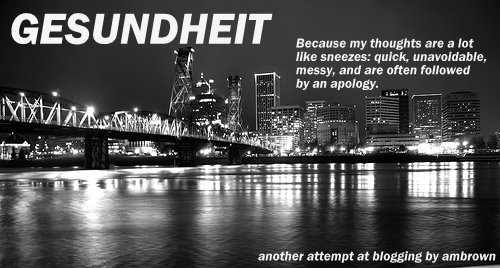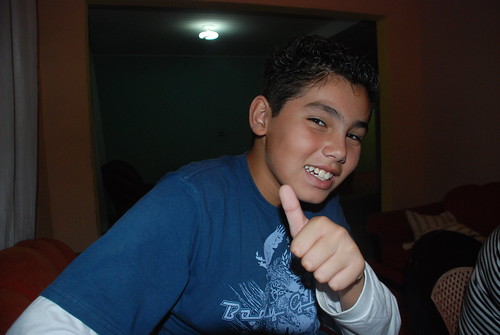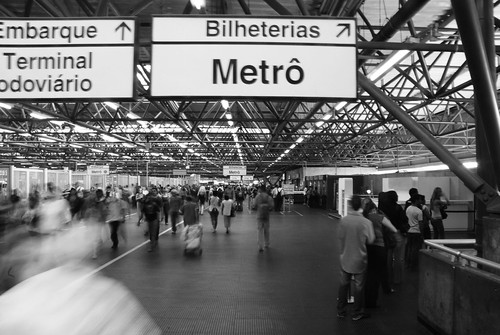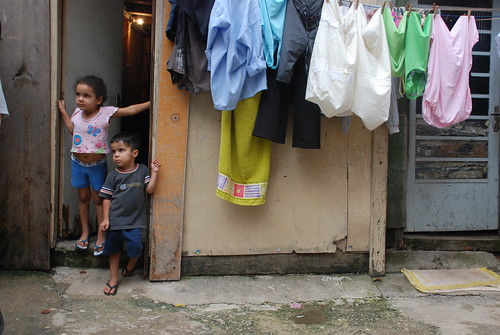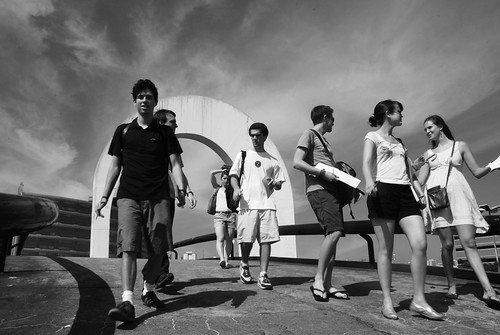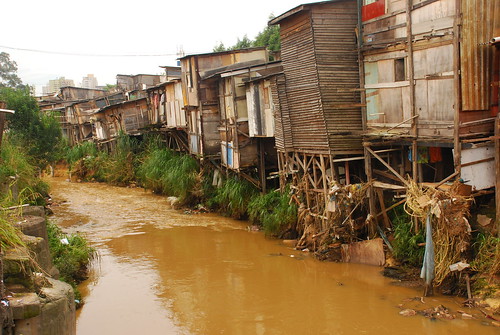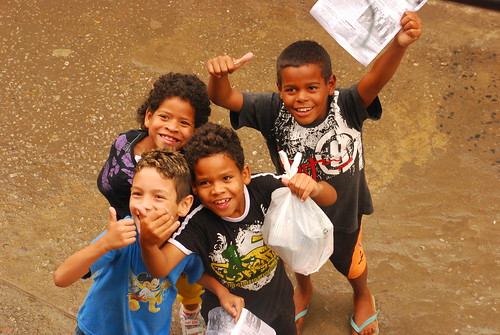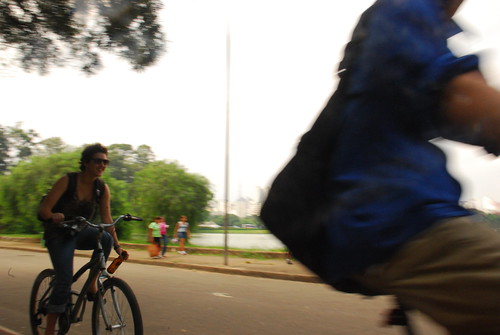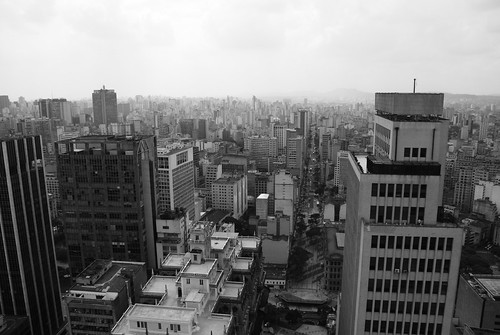Wait until I tell you about my host family here in Curitiba. I spent the day surrounded by extended family, none of whom speak any english. I met grandmothers, aunts, cousins, and was generally overwhelmed the entire day. I just posted like fifty photos of our visit to the Movimento dos trabalhadores rurais sem terra settlement, go check them out on flickr.
Curitiba is a lot like Portland, and if this is so, we live in the Troutdale of Curitiba.
26.2.09
My 13 year old host brother.
25.2.09
Good Morning São Paulo
I am currently in a hotel, after being in transit from São Paulo and an MST settlement and heading towards Curitba, where we will stay with a new host family tomorrow. I´m up late for no reason, and i still have a small paper to write for tonight (hooray!), but since Í´m getting lonely and all, here are some addresses to which you should send some postcards. Another girl on the program requested mix CDs of new hip music and of crappy American food, but I´ll settle for updates from the Macalester bubble or from wherever else in the world you might be hanging out.
March 4th through early April:
Aaron Danger Brown
c/o Sally Frankental
Department of Social Anthropology
University of Cape Town
Rondebosch 7701
South Africa
mid April through May 15th.
IHP c/o Hoai Anh Tran
For Aaron Danger Brown
E4 Ciputra Rum 804
Phu Thuong Ward
Tay Ho District
Hanoi, Vietnam
Please keep in mind how fast (read:slow) mail takes, and plan accordingly.
Having the trip of a lifetime.
22.2.09
On "Taking" Photos, Carnival and leaving São Paulo
Portland, Orygun, Cascadia - Dec 15 to Jan 19
New York, New York, USA - Jan 19 to Jan 29
São Paulo, Brazil Jan 30 to Feb 22
Curitibas, Brazil, Feb 25 to Mar 4
Cape Town, South Africa Mar 5 to Apr 10
Hanoi, Vietnam Apr 11 to May 15th
I bought my first digital camera the fall of my senior year of high school, after having a dorky interest in Photography spurned by my father, my friends Sharat and Alex, and a few family vacations where it felt so necessary to capture the essence of wherever I was in some sort of image to take home. It was a respectable Canon point and shoot, and the camera became attached to my right hand by the end of my senior year. My photos were never really that fantastic, but I whored them out on flickr and used a somewhat religious fervor to tag and group my photos to get attention, and I ended up getting a handful of photos into Flickr´s Explore. The winter of my freshman year of college, I bucked up and bought my baby Nikon D80 that I have now, a mammoth DSLR on which I have taken tens of thousands of photos, to multiple music concerts and festivals, through the hottest summer days in Portland to the worst coldsnaps in Saint Paul, to sunrises and sunsets, to at least seven countries, to beaches and cities, to lakes and parties, and even, once, to the top of an active volcano. A year as the school newspaper´s photography editor pushed me to think objectively, as though I was a fly in the room, and to take interesting photos of the boring speakers or new recycling initiatives that inevitably comprised the college´s weekly news. While this screams of an entry from the blog stuffwhitepeoplelike, I am happiest when I am biking somewhere around the Twin Cities, feeling caffeine flow through my system and stopping to whip my camera out of my messenger bag and take a photo of a nice urban landscape. I also invested in some toy film cameras as well, and over the past few months I´ve been slowly working on understanding my dad´s old film SLR that I robbed from his closet about a year ago. Thanks to the degree to which I´ve managed to keep a camera within arms reach over the past four years, I have what I would consider to be a pretty impressive collection of visual images that represents just about everywhere that I have been around the planet for the past three and a half years. Many of my photos aren´t that great (especially the old ones) and I can hardly claim to really, truly understand the intricacies of photography the way that professionals, journalists and artists do, but I enjoy finding ways to frame images, people, and places where I am in some sort of memorable, interesting way.
The point of this blog entry was to ask the simple question: why? Upon looking at my flickr stream, going all the way back to the days in E-hall at Sunset High School, it is pretty interesting to see just how many photos I have taken, how many times I have put a proverbial and literal lens between me and a subject I wished to document. While all those new, flashy point-and-shoot cameras have gigantic LCD screens on their backs and people can take photos while holding their camera at arms length, all of my cameras demand that I look through the viewfinder, thereby inherently distancing myself from a panoramic world in which I stand, and find a limited 4x6 area in which some part of my surroundings are framed and depicted. Furthermore, once I have found a particular frame I wished to leash around a subject, and played with whatever sort of lighting/shutter/apature/film speed/color setting that represents my artistic view on it, I press a button, and the photo is forever stored as a jpg file with thousands and thousands of little pixels of varying hues, waiting for me to find a computer and upload it. And then there! I have proof I saw this particular image, I was somehow related or proximate to this particular combination of time and place, and through the means of the internetz I can show that I WAS THERE.
I guess I´m still beating around the bush about the original question, as to why to photograph. As my study abroad program tours Sao Paulo, at any given moment at least 75% of us have cameras on our body, ready at any moment to document any particular moment so that we can upload it to facebook and flickr and impress our friends with the absurd things we´ve seen. Often we pose; hey, look, here I am on top of a very tall building with an incredible view, let it be known that I WAS HERE, and I have moved on to somewhere else where I WILL ALSO BE SEEN, and MY EXISTANCE HERE WILL BE DOCUMENTED. Considering even the cheapest cameras cost about $200, and my baby cost conciderably more than that, and flight travel of almost any sort necessary to visit far away countries is exorbitantly expensive, I often see my desire to chronicle my ability to go to cool places as a luxury, with mobility and documentation as priviledges not afforded to all. This becomes even more frustrating when our program visits Brasil´s sprawling favelas; why am I taking a photo of these kids standing outside their tiny shack of a house? Even more discouraging is when my desires to photograph the shockingly destitute is multiplied among our group as a whole; suddenly, we are the paparazzi, a swarm of mostly-american kids trying to best chronicle what we have seen, and what we will be able to freely escape upon the timely arrival of our bus back to our comfortable homestays. To be fair, these photos can serve a point, and can work towards positive agendas; being able to look through old photographs can help reshape forgotton memories, and there are countless examples of photojournalism and art that have served important causes.
In a related note, Friday night was Carnival. While São Paulo´s Carnival is a shadow of the Carioca parade that will dominate international headlines in the upcoming days, the feat is undoubtedly impressive: at least a dozen samba schools have a full hour to march down the Sambadromo, each school with around three thousand people and divided into subgroups all organized and decorated around a particular theme, with much singing, dancing, euphoria, and nudity. I was fortunate enough to be able to march in the Carnival with the first school of the night, Escola de Peruche, and then watch the rest from the stadium seating that lines the constructed avenue, the sanitized arena that represents the original streets where communities gathered and took over neighborhoods for their own causes. While I have a bazillion thoughts about Carnival and how it might be one of the greatest experiences I´ve had in my entire life, I did not have a camera with me. For the most outlandish, ostentious, colorful, meticulously planned (and framed?) event I´ve ever attended, I went sans camera, since my hulking Nikon would be a bit of a bummer while dancing the Samba in front of the giant crowds. While many of the other kids on the program had cameras and took some incredible photos, (and Hayden´s blog gives a pretty good detail of what went down), I had no choice but to not distance myself from the event and watch the glitter float down from the sky with my own eyes, without the help of a camera lens (although my lenses of my glasses sure helped). Carnival can´t really be documented or described, one of our readings described, only experienced. And I can only conclude that the same is true for travelling in general. In fact, taking photos probably makes it harder to truly experience anything; the necessary fudging with camera controls and calculating light/apature ratings put a strain on one´s abilities to smell the sewage in the water in Diadema, to feel the combination of smog and sweat that hangs heavy in the subway stations, or to even be able to treat others as equals. When I walk in with my 135mm lens and attempt to use it to distance myself from my subject by pressing that shutter button, I am quite literally "taking" a photo; I am not, as photojournalism as a profession and medium so desperately attempts to claim, merely a fly on the wall, but a living, breathing person often attempting to put other living, breathing people into some sort of frame that communicates the world I would be actively describing if I wasn´t actually ratcheting up the shutter speed. Unfortunately, this is something that I can´t immediately resolve without entirely dropping photography, and that´s something I´m hardly prepared to do at the moment. I guess I can only try to continue to be conscious of what I´m taking photos of, and continue to critique myself as to why I want to be seen in a certain environment, why I want others to be seen in a certain environment, and what purpose my photos are serving and will serve as I return home.
I´m leaving São Paulo tomorrow. I´m going to miss this absurd city. I will miss Aldeni, my host mom, and her high-pitched voice and incredible cooking, and I will miss the hyper-concentrated tension that takes shape in everything from the rain clouds to traffic congestion to social inequity, and I will definitely miss the hipster bar Menos we found near Paulista that played Spoon, The Smiths, The Postal Service, Q and not U, Belle and Sebastian, the Breeders, Modest Mouse, and Wilco, but I am excited for a change of scenery. I am looking forward to a breath of fresh air (literally) in Curitibas, and my next host family sent me an incredibly adorable email. Before we go to Curitibas, we´re stopping in with MST, a radical Brazilian land reform group, which will likely prove to be pretty interesting. And on final note, this marks the end of my stay with my roommate here in São Paulo, Michael, who has been absurdly nice in letting me use his laptop to waste copious amounts of time on the internet; expect fewer entries and musings and photographs in the weeks to come.
Return, I will, to Old Brazil...
19.2.09
18.2.09
"If I were starting a business, it would be in either concrete or hair gel. I'd be the richest man in Brazil."

Avenue Paulista - Sao Paulo, Brazil, originally uploaded by Aaron Michael Brown.
Some people were complaining about the look of this blog, so I've done some HTMLing, and added my top 100 favorite blogs to the sidebar. Now you can procrastinate just like I do!
This is a quick entry to write about the horrendously intense clouds that were looming over Avenue Paulista this afternoon. The day had started with an unbearable 90 degrees of heat and humidity and awfulness, but as the day wore on, and I know this is a cheap cliche but I'm running with it, you could palpably feel the tension in the sky as the clouds rolled in and got ready to rain like all get out as it tends to do here in Sao Paulo. Granted, this afternoon we were spared the onslaught, but after years and years of Portland's six-month someone-left-the-faucet-on-upstairs drizzle, the sheer volume of the water falling from the sky is quite impressive. Even the storms in Minnesota's summer, complete with afternoons spent in the basement listening to the radio for information on tornadoes, doesn't quite compare. Sao Paulo is a pretty tense city; the streets are loud and full of cars that won't cede an inch to pedestrians, the pace is fast and the fumes noxious, and the general concrete fortifications that parcel out this entire city create a pretty stressful metropolis. I've already written some on the way safety is constructed spatially and it's relationship to health, and considering how much of a beating Sao Paulo has already given to my lungs (pollution), my liver (caipirinhas), and now my heart (all this stress) it becomes a lot easier to see the tolls and frustrations with urbanity that have long driven everyone from Thoreau to the Brady Bunch to my parents to choose shelter by living in the suburbs. I wrote about New York a few weeks ago, comparing the city to Anne Spirn's conceptual Granite Garden, but here in Sao Paulo the term "Granite Jungle" seems more fitting; Sao Paulo humid, sticky, and full of the invasive species of homo concreteus-sprawlicus that suggests that guiding growth of the city is impossible. After a particularly busy day on the train system today, a suburban commuter line pulled above ground to a neck of town I had never visited before; the urban landscape still continued in all directions, as far as I could see. The enormity and sheer size of Sao Paulo remains conceptually out of my grasp, especially as a kid used to living within a mile of Portland's Urban Growth Boundary. But I digress. I have more that I want to write about water in the city of Sao Paulo (specifically in the way that the rivers have been straight-jacketed with concrete and asphalt, like everything else in this city, and the torrential summer floods turn the steep city street gutters into gushing streams, guiding the water to who-knows-where downstream where someone less fortunate probably lives) but I should be sleeping to rest up for Carnival this weekend, the futebol game tomorrow, and hell, even some academic work somewhere in there.
To end on a happy note, I arrived early to the Metro station today, and while flustering about my generally horrendous Portuguese, the woman working at the convenience store took a liking to me and, after asking where I was from, gave me my coffee for free. This only really saved me about forty five cents - the Real/Dollar conversion rate is generous - and they only serve coffee around here in the tiniest thimble-like shot glasses, but it made for a good start to my day. I've also been meaning to write about experiencing culture through literally consuming it in the form of Brazilian takes on pizza, sushi, mangoes, alcohol, and the like, but that post will come in time too, I guess.
On another happy note, I received the most adorable email from my next host family in Curitibas. I'm pretty sad to leave Aldeni, my mom-away-from-mom who feeds me super well and greets me with a long, cheerful "Oi!" every time I come home from class, but this program is of course continuing at break neck speed. I've been on IHP for about a month?! What?!
16.2.09
Paulistanos
"Anyone who predicts the death of cities has already met their spouse".
-Clay Shirky, Here Come's Everybody.
Some sort of holiday passed this weekend back in the states about love and relationships and Hallmark cards and those heart-shaped candies that are delicious in January but always manage to be pretty stale and chewy by the time the actual day itself rolls around. But yes, Valentine's Day. Here in Sao Paulo, there was no perceptible uptick in romance, lust and love, but then again, it would be difficult for people in this city to live more passionately anyway. In my travels around the city, love is surprisingly in the air around every turn; couples seem to really get into tonsil hockey pretty much anywhere, whether on the street, the 701U onibus that takes me to class, the Universidade cafeteria, bars and restaurantes, wherever, really. With a quick conversation and a "você quer ficar comigo?" almost any two clubbing brazilians will swap saliva for a while and then get back to the club, commitment-free, to see who else is around. Kissing isn't just for hardcore making out, either; it's traditional to kiss someone on the left side of their face when first meeting them, a practice that I find fascinating because of what it says about construction of gender relations (men never greet other men with a kiss, only man/woman and woman/woman) and the different sort of cultural understandings of personal space, physical intimacy, and "closeness" different societies create for themselves.
Talking about "closeness" in Brazil is a pretty decent segway, really, into talking about the urban form here in Sao Paulo. My study abroad program has done a pretty stellar job of encouraging us to explore and understand the urban fabric here in a city teeming with twenty million people, unbearable heat, and blunt social inequality. In a city with such absurd power imbalance and a premium for basic social services, the differences of Paulistano lifestyles and abilities for to control their surrounding environment create blatantly absurd landscapes. On consecutive days we visited a fortified enclave of million-dollar condominium towers in suburban Morumbi followed by a visit to a Favela, a courageous undertaking by urban homeless to reclaim unused private land and scour for discarded concrete to build an informal, undocumented neighborhood. The contradictions between these two landscapes are many, and I was really happy to see that one of our readings referenced Mike Davis and his notion about the creation of a geography of fear. Are people in those high towers, with 150 security personnel and gates and guarded entries, really safe at night? Do they feel safe at night? Are the people in the tiny shacks and beer-bottle-window favelas, with neighborhoods ardently guarded by druglords and an unspoken dominant power hierarchy, really unsafe at night? Do they feel unsafe at night? We had a fantastic speaker last week that really challenged our notions about safety, and how its constructed spatially, and I couldn't help but link it to health. In the city of Sao Paulo, with traffic galore, everyone feels safer using an automobile to get around, and most cars own the streets by even run red lights at night to avoid carjacking. Yet the air pollution is abundant here; every day's worth of air here is equivalent to smoking three cigarettes, a nasty, uncomfortable pollution that clings to your skin in the muggy weather and never quite gets scrubbed off, much of it mostly related to the supreme reliance of cars necessary to get around the city. While kidnappings are rampant here in Sao Paulo, I'd argue the nasty air here is just as likely to kill you. Perhaps in the 21st century, its time for cities to start developing a geography of fear that doesn't build walls and install fortified security cameras but instead well-lit mass transit, wind turbines and sidewalks.
This computer's battery is low, and while I want to write so much more about my trip, I probably shouldn't, at least not tonight. I apologize for cutting my last entry short (i think my roommate clicked "post" before I was ready to), and I'll try and keep current with whatever I'm up to. It's Sunday, we watched a great football game today, I had the best pizza of my life last night at three in the morning, Carnival is this next weekend, and I leave for MST and Curitibas sometime next week. I apologize for my above attempt at linking my experiences to Valentine's day, and doing so a day late anyway. I've already been on IHP for about a month?!
Tudo Bem.
13.2.09
Life in the Cidade
According to GOOGLE ANALYTICS, the link to this little ol' blog of mine from Kira's Out of a Suitcase has resulted in a whopping six hits from Poughkeepsie, New York
The Summer's Life is Good
Still alive, having a great time in São Paulo. I´ve been collecting a handful of scribbled notes about things I want to blog about, so stay on the edge of your seats, a significant update may be coming your way this weekend.
Happy Birthday Oregon! 150 years, and never looked better.
9.2.09
More ruminations on contested spaces and colors.
Later that week, we went to a Samba School, in which the group is eagerly practicing for the upcoming celebration of Carnival, and they too were able to formally close down the streets so that the 50 part drumline, the dancers and the singers could practice strutting their music and costumes. They played one song for about twenty minutes, which had a chorus about how Samba is in everyone's DNA, and watching this tiny older woman move to the beat and shout every word of every song made me think about how lame America is and how much I wish Americans made it a point to celebrate life more often. There's something fantastically emblematic about shutting down the streets for cars, stopping traffic and formal commerce so that the entire block can be turned into a setting for a party with cheap, informal food shops, lots and lots of dancing that goes on all night, and an opportunity to get out and reclaim all of that public space for yourself.
And to speak of contested space, you can't talk about cities without talking about density. I think the first time I really noticed it on this trip was in New York, where I would have difficulty maneuvering around the tiny tables at cramped restaurants, each arranged to fit as many people into the place as possible. There is such a premium on space, such a demand to use it efficiently and for a profit, that the whole island of Manhattan was built on a grid to make it easier for speculators hundreds of years ago to purchase their plot and make their investments. Here in Sao Paulo, I see the contests of density not so much in restaurants as in traffic. Cars flood the streets in Sao Paulo, and traffic is a mess as people use buses, subways, cars, and even helicopters for the very rich to get around this sprawling metropolis. On Consolacao, a major road leading towards our University, there are miles of buses clogged on the bus lane, each bus beyond capacity with heads sticking out of windows to grasp a bit of less-humid summer air, while the next two lanes in each direction are full of sparcely populated cars, each comfortably sitting in their own spheres of comfort, a space in which 15 people would fit with the same density as the bus. I can't help but think about the notion of transportation justice, as we read and hear about poor construction workers and house maids who commute hours upon hours, standing on buses to get into the inner city and retreat to their favelas or farther outposts away from our garden city, well kept neighborhoods.
Speaking of colors, I am horrendously red from my trip to Ilhabela, which might be one of the most serene places I have visited on earth. I will write more about all that later, but I'm trying to keep my posts short and relevant, neither of which will happen if I allow myself to continue rambling on. Life is good, and I am sunburned.
3.2.09
Third Largest City in the world
20 million is a lot of people.
As I think of the next thing worth blogging about, be sure to check out my photos at http://www.flickr.com/photos/dietpoison. I post the best photos here, or at least the ones most pertinent to whatever I'm thinking about, but I'll be keeping my flickr fresh, at least until we leave for Curitibas. I'm fortunate to have a nice (read: understanding) roommate that is allowing me to relinquish my internet needs for the next few weeks by letting me use his computer to updatez my google readerz and see the top stories (Daschle? Transit Stimulus Bills? Blazers over Hornets? Funny hipster runoff posts?) and update this blog. My family is absurdly wonderful to me, Aldeni makes me a giant plate of food every night, and her chirpy English is better than my emerging (read: nonexistant) Portuguese. Things are looking as though we'll be heading to Ilhabela this weekend, an island a few hours northeast of here out in the Atlantic covered in rainforest, and I'm sure that'll bring about many pretty photos, stories, and blogworthy ideas. Until then, I'm trying to come up with some sort of connection between how, you know, I go to school in St Paul, and now i'm in Sao Paulo, and how different they are/similiar they are, you know... yeah.
1.2.09
São Paulo
I took so many photos in New York in black and white, and why not? Winter in The City means short days, lots of artificial lighting, washed out condescent-lit faces, and shooting black and white (especially with contrasty settings and high iso) helps photos take on that gritty, blunt, stiff aura about The City that I wrote about a few days ago. New York in January, not unlike in many other months, is the product of an almost entirely man-managed environment forced to deal with extreme temperature, unpredictable weather, and even snowfall, all of which are natural features that mankind is only starting to learn to manipulate and to which we are largely at the fate of mother nature. While residents of New Orleans and other sites of natural disasters can justifiably claim that there is a spatial, social logic as to who takes on the blunt of environmental hardship, we have obviously not found a way to prevent the environment from figuratively/literally raining on our parades and adversely impacting ourselves, especially those of us in cities, the places that are seemingly the farthest removed from nature in the first place. But I digress. Even on the crisp, sunny days we enjoyed during my stay in The City, I found that shooting in color didn't represent the way the Brooklyn Bridge, the 1 line Subway or the South Bronx and the people who inhabit these spaces defiantly built, shaped and reshaped their environment. The 125th St Subway station in New York is such a testament to audacity; who dreamed up building such a large lattus of steel to move the subway above the smaller valley? Similiarly, the efforts to pull the South Bronx out of disinvestment and urban blight are best viewed through black and white; the racial disparity of urban society are still clearly demarcated, but the film exposes all the shades of grey that exist only when you look for them.
And yet, after a ten hour sleepless flight and waking up in São Paulo, all I see is color, color, color. The different colors of skin on the streets, where race is also heavily contested yet constructed in so many unique ways, the colors of the absurdly potent caipirinhas and other drinks at The City's voracious bars, the vibrant colors of the sunset that sneaks through endless lines of towers, the colors of the delicious mangoes I am graciously fed by my host family with every meal, the colors of graffiti and murals on every wall that, not unlike New York's own citizen initiatives, hint at an underground meritocracy where anyone with creativity and drive can have a lasting impact on the built environment, or even the figurative colors of portuguese, a language that is as much about expression and emotion as it is about grammar, where the innovative pronounciations of the letters C, J, and D keep the language bouncy and keep me on my heels as I navigate a country and language in which I'm inescapibly, entirely immersed.
But perhaps most prominent are the colors of a warm, southern hemisphere summer and an oppressively hot sun that watches my every move and oddly sets in the North. Things have been cold for a while. If you look at this blog, I've been posting my favorite photos since December, almost entirely in black and white, photos that look great on a bleak, black background that tried to convey that blurry-eyed bon-homie from late night hotcakes and coffee back in Portland. But in so many ways, I'm not there any more. There are just too many colors in São Paulo to rely on those quiet nights for entertainment, to dwell on the harsh, dark urban landscape, and above all, to shoot in black and white.
In other news, I definitely scored the email address of an attractive brazilian girl at a bar last night. As they say in Brasil, Tudo Bem.
